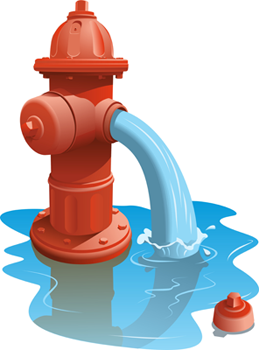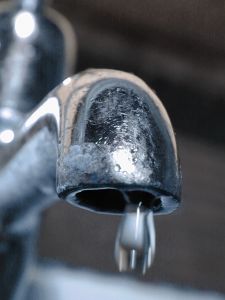What Causes Rusty Water?
Posted: Wednesday, May 18, 2016
 Customers occasionally ask us, "what causes dirty or rusty water, and is it safe to drink?" Rusty water may look and taste unpleasant, and possibly stain sinks and clothing, but it is not a health concern.
Customers occasionally ask us, "what causes dirty or rusty water, and is it safe to drink?" Rusty water may look and taste unpleasant, and possibly stain sinks and clothing, but it is not a health concern.
Rust is oxidized iron, and is introduced to tap water from the corrosion of the water mains under the street and/or the plumbing inside your home, apartment, or business. Tap water can turn brown, red, orange, or yellow due to the iron particles that break free from corroded iron or steel pipes. Corroded pipes are common in most North American cities, where many water systems were originally installed over a century ago.
You can determine if your water discoloration is caused by the municipal water supply or your home's internal plumbing.
Discoloration Caused by Water Mains
 Rust and sediment is always present at the bottom of water mains, and regularly mixes with drinking water in microscopic amounts. Certain events can stir up the sediment in the water mains, causing discoloration as the particulates become visible to the naked eye, including water main breaks during the winter, water main replacement during construction projects, vehicular accidents involving a fire hydrant, fire fighting efforts with high water use, or other disturbances that cause a significant change in water flow. Water discoloration can also occur in areas of low water flow, such as cul-de-sacs and dead-end roads.
Rust and sediment is always present at the bottom of water mains, and regularly mixes with drinking water in microscopic amounts. Certain events can stir up the sediment in the water mains, causing discoloration as the particulates become visible to the naked eye, including water main breaks during the winter, water main replacement during construction projects, vehicular accidents involving a fire hydrant, fire fighting efforts with high water use, or other disturbances that cause a significant change in water flow. Water discoloration can also occur in areas of low water flow, such as cul-de-sacs and dead-end roads.
Stoughton Utilities flushes our 70 miles of water mains at least once per year, which allows us to not only remove any sediment that has accumulated in the mains, but to also verify the proper operation of hydrants and valves and maintain firefighting capabilities. Although this flushing is essential to provide high water quality and prevent long-term sedimentation and discoloration issues, it can cause short-term discoloration as the sediment is disturbed due to the higher water flows.
When sediment gets stirred up in the water system, the resulting discoloration will typically last approximately 2-4 hours or less. After this time, the sediment will settle back out and the water will become clear. You can speed up the process by turning on the cold water tap at full pressure nearest where the water enters your home, such as a basement laundry tub, or a first-floor sink, and allowing the water to run until it is clear. During these periods, it's important to try to avoid using hot water, as the sediment can be drawn into your hot water heater's water tank, which could require you to have to flush the tank later.
Signs the discoloration is from the underground water system- Only the cold water is discolored.
- The discoloration affects all faucets and taps in your home or business.
- The discoloration takes two or more minutes to clear when running a tap at full pressure.
- The discoloration continues to be present hours after your first notice it.
Discoloration Caused by Your Plumbing
Just like the underground water mains corrode over time, so does the plumbing inside your home, apartment, or business. You can often know that the discoloration is a problem with your internal plumbing if rust appears only in your hot water, come only from certain faucets, or clears very quickly after running the water.
 Internal plumbing is typically constructed using either copper or galvanized steel. Copper pipes are generally considered to be better, since they last longer and typically don't significantly affect water quality as they age. Galvanized steel, on the other hand, typically last twenty years before they show signs of corrosion and rust. Replacing galvanized steel plumbing with copper can improve your internal water quality and prevent discoloration, but it's important to never connect copper pipes directly to steel pipes, as this can actually increase the corrosion of the steel. Be sure to use the proper dielectric couplings when connecting the two dissimilar pipe materials.
Internal plumbing is typically constructed using either copper or galvanized steel. Copper pipes are generally considered to be better, since they last longer and typically don't significantly affect water quality as they age. Galvanized steel, on the other hand, typically last twenty years before they show signs of corrosion and rust. Replacing galvanized steel plumbing with copper can improve your internal water quality and prevent discoloration, but it's important to never connect copper pipes directly to steel pipes, as this can actually increase the corrosion of the steel. Be sure to use the proper dielectric couplings when connecting the two dissimilar pipe materials.
Signs the discoloration is caused by your internal plumbing- The water is discolored every morning, or when first used after several hours of inactivity.
- The water clears after it has run for a few seconds or minutes.
- The discoloration affects only certain faucets, but not all of them.
- The discoloration affects only the hot water, and the cold water tap runs clear.
- The discoloration clears after changing a water filter located inside your property.
Laundry Tips
If you were in the process of washing laundry during a discoloration event, rewash the laundry once the water has cleared. Be sure to not dry them in the clothes dryer before treating the stains or rewashing, as the heat may cause the stains to set, and make them difficult or impossible to remove. When washing, use a rust stain remover or regular detergent, but never use chlorine bleach which can react with iron to form a permanent stain.
Contact Us
If you've reviewed the tips above and determined that your water's discoloration appears to be caused by the municipal underground water system, please contact us and our customer service staff will review your situation and dispatch a water operator to analyze your neighborhood's water quality.